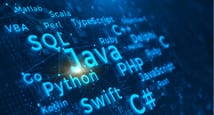- Introduction to Course
- Course Contents
- Control the Pace of a Lesson
- Introduction to Data Mining
- Data Mining Definition
- Business Applications of Data Mining
- Data Mining Process Pyramid
- Introduction to Machine Learning
- Machine Leaning Sub-fields.
- How Does Machine Learning Work
- Train and Test Sets.
- Machine Learning Algorithms Types
- Machine Leaning Types
- Reinforcement Learning overview
- Course Rating
Learn Data Mining and Machine Learning With Python
Quick Facts
| particular | details | |||
|---|---|---|---|---|
|
Medium of instructions
English
|
Mode of learning
Self study
|
Mode of Delivery
Video and Text Based
|
Course overview
Python is a general-purpose, high-level programming language. Its design philosophy prioritizes code readability by employing extensive indentation. There is dynamic typing and garbage collection in Python. It's compatible with a number of programming styles, including procedural, object-oriented, and functional. It has a large standard library, so it is often called a "batteries included" language. Python can be used for more than one type of programming. Full support for Object-Oriented and Structured Programming; partial support for Functional and Aspect-Oriented Programming including metaprogramming and metaobjects. Extensions support numerous other paradigms, including design by contract and logic programming. Learn Data Mining and Machine Learning With Python certification is made available by Udemy to candidates who want to master all aspects of data mining and its applications.
Learn Data Mining and Machine Learning With Python online training Include 8.5 hours of video, eleven articles, 32 downloadable resources, and a digital certificate upon course completion.
Learn Data Mining and Machine Learning With Python online classes consists of an introduction to data mining, Installation of anaconda package, supervised learning algorithms, unsupervised, and deep learning
The highlights
- Full Lifetime Access
- 8.5 hours on-demand video
- Eleven Articles
- 32 Downloadable Resources
- Access on Mobile and TV
- Certificate of Completion
Program offerings
- Online course
- Learning resources
- 30-day money-back guarantee
- Unlimited access to course material
Course and certificate fees
Fees information
certificate availability
Yes
certificate providing authority
Udemy
Who it is for
What you will learn
Learn Data Mining and Machine Learning With Python certification course, the applicant will learn everything about data mining and its applications. The applicant will understand machine learning and its connection with data mining, machine learning algorithms, their types, and their usage in business, and how to implement machine learning algorithms in different business scenarios. The aspirant will get to know how to install and use a python programming language to create machine learning algorithms, how to import data sets into python, and make required cleaning before creating the algorithms. The candidate will acquire knowledge on how to interpret the results of each algorithm and compare them with each other to choose the optimum one as well as create graphs in pythons, such as scattered and regression graphs, and use them in their analyses and learn data analysis in Python Spark.
The syllabus
Introduction to Data Mining & Machine Learning in Python (Course 1)
Setup Programming Environment
- Install Anaconda package
- Introduction to Jupyter
- Introduction to Python Part-1(Create Lists)
- Introduction to Python Part-2 (Create Tuples & Dictionaries)
- Introduction to Python Part-3 (Loops & Functions)
- Introduction to Pandas Library
- Introduction to NumPy & Matplotlib Libraries
- Introduction to Scikit-learn Library
Supervised Learning Algorithms
- Introduction to Supervised Learning Algorithms
- Types of Variables
- Data Types
- Introduction to Regression Analysis
- Regression Model
- Regression Model Slope
- Regression Slope
- The Intercept Value
- The Intercept Value
- R-Squared
- P-Value
- Simple Linear Regression
- Concepts used in Machine Learning (Important**)
- Overview on the dataset
- Create Simple Linear Regression Model in Python-Part 1
- Create Simple Linear Regression Model in Python-Part 2
- Create Simple Linear Regression Model in Python-Part 3
- Create Simple Linear Regression Model in Python-Part 4
- Create Simple Linear Regression Model in Python-Part 5
- Multiple Linear Regression
- Dummy Variables
- Dummy Variables Trap
- Step-wise Approach
- Assumptions of Multiple Linear Regression
- Overview on the business problem data
- Create Multiple Linear Regression Model in Python-Part 1
- Create Multiple Linear Regression Model in Python-Part 2
- Create Multiple Linear Regression Model in Python-Part 3
- Create Multiple Linear Regression Model in Python-Part 4
- Polynomial Regression
- Overview on the business problem data
- Create Polynomial Regression Model in Python-Part 1
- Create Polynomial Regression Model in Python-Part 2
- Create Polynomial Regression Model in Python-Part 3
- Course Rating
- Introduction to Classification
- Introduction to Logistic Regression
- Confusion Matrix
- Standard Scaler
- Overview on the business problem data
- Create Logistic Regression Model in Python-Part 1
- Create Logistic Regression Model in Python-Part 2
- KNN Classification Algorithm
- Create KNN Model in Python
- Support Vector Machine (SVM) Classification Algorithm
- Create Support Vector Machine in Python
- Naive Bayes Algorithm Part 1
- Naive Bayes Algorithm Part 2
- Create Naive Bayes Model in Python
- Decision Tree Algorithm
- Create Decision Tree Model in Python
- Random Forest Algorithm
- Create Random Forest Model in Python
- Course Rating
Unsupervised Learning Algorithms
- Review Unsupervised Learning Algorithms
- Hierarchical Clustering Algorithm
- Dendrogram Diagram Method
- Overview on the business problem data
- Create Hierarchical Clustering Algorithm in Python-1
- Create Hierarchical Clustering Algorithm in Python-2
- K-means Clustering Algorithm
- Using Elbow Method to Determine Optimal Number of Clusters
- Create K-means Clustering Algorithm Model in Python - 1
- Create K-means Clustering Algorithm Model in Python - 2
- Association Rules (Market Basket Analysis)
- Overview on the business problem data
- Create Association Rules (Market Basket Analysis) Model in Python - 1
- Create Association Rules (Market Basket Analysis) Model in Python - 2
- Create Association Rules (Market Basket Analysis) Model in Python - 3
Deep Learning
- Introduction to Deep Learning
- Use Deep Learning in Classification
- How Does Deep Learning Work
- Activation Functions
- What is Tensorflow
- Introduction to the Deep Learning Problem and Dataset
- Create Artificial Neural Network Model in Python Part-1
- Create Artificial Neural Network Model in Python Part-2
- Create Artificial Neural Network Model in Python Part-3
- Course Rating
Appendix: Statistics Overview
- What is Statistics
- Sample And Population
- Descriptive and Inferential Statistics
- Data types
- Visualize Data
- Histogram
- Central Tendency Measures
- Variability Measures
- Calculate Central and Variability Measures (Practical)
- Symmetry and skewness in data
- Correlation and Covariance
- Introduction to Inferential Statistics
- Discrete Probability Distributions
- Normal Distribution
- Variable standardization
- Variable standardization Demo
- Introduction to Central Limit Theorem
- Estimators
- Introduction to Confidence Interval
- Calculate Confidence Interval for one Sample with a Known Population Variance
- Introduction to the Business Problem
- Calculate Confidence Interval in Excel
- t - Distribution
- Calculate Confidence Interval for one Sample with a Unknown Population Variance
- Reduce Margin of Error
- Confidence Interval for two Dependent Samples
- Calculate Confidence Interval for two Dependent Samples in Excel
- Confidence Interval for two Independent Samples with a Known Population Variance
- Calculate Confidence Interval for two Independent Samples Known Var in Excel
- Confidence Interval for two Independent Samples Unknown Population Variance
- What is a Statistical Hypothesis
- Types of Hypotheses
- P-Value
- Link to z-value Calculator
- Testing a Hypothesis for one Sample, Variance is Known
- Testing the Hypothesis in Excel
- Testing a Hypothesis for one Sample, Variance is Unknown
- Testing a Hypothesis for two Dependent Samples
- Link to t-value Calculator
- Testing a Hypothesis for two Independent Samples, Variance is Known
- Testing a Hypothesis for two Independent Samples, Variance is Unknown


 Brochure
Brochure Enquire
Enquire










